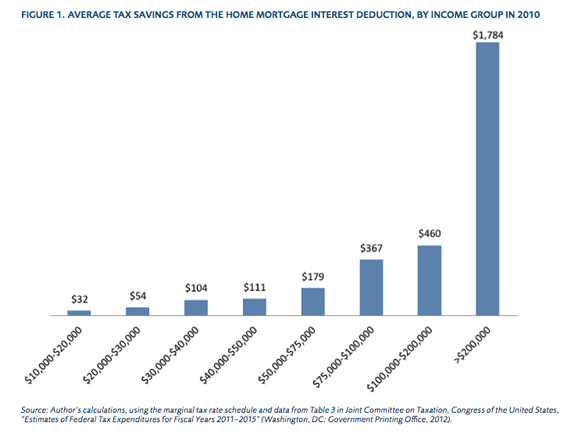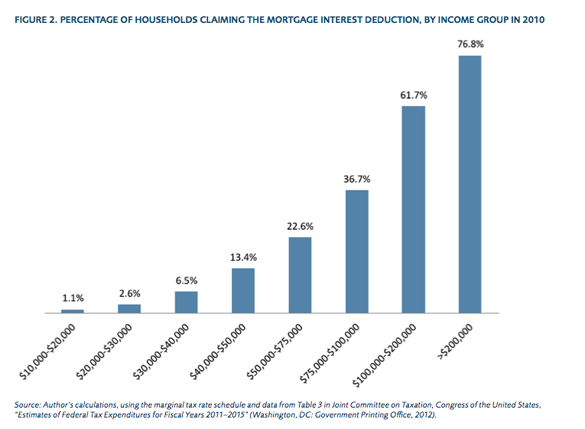- | Academic & Student Programs Academic & Student Programs
- | Government Spending Government Spending
- | Policy Briefs Policy Briefs
- |
The Home Mortgage Interest Deduction
The home mortgage interest deduction is the largest explicit tax deduction for households in the federal income tax code. Politicians have been reluctant to even consider removing this deduction, believing it to be one that provides significant benefits to middle-class taxpayers and encourages homeownership. These benefits are greatly over- stated: most taxpayers do not benefit from this deduction at all or receive a very small benefit. The only taxpayers who do receive a large benefit are those in the upper income brackets. Taxpayers and the entire economy would be better served by removing the mortgage interest deduction and lowering marginal tax rates to offset the change.
The home mortgage interest deduction is the largest explicit tax deduction for households in the federal income tax code. Politicians have been reluctant to even consider removing this deduction, believing it to be one that provides significant benefits to middle-class taxpayers and encourages homeownership. These benefits are greatly over- stated: most taxpayers do not benefit from this deduction at all or receive a very small benefit. The only taxpayers who do receive a large benefit are those in the upper income brackets. Taxpayers and the entire economy would be better served by removing the mortgage interest deduction and lowering marginal tax rates to offset the change.
The mortgage interest deduction is a tax deduction by which the federal government allows taxpayers who own their homes to lower their taxable income by the amount of interest paid on loans for a principal residence or a second home. As such, the mortgage interest deduction, like other deductions in the tax code, allows taxpayers to subtract the costs of certain items of consumption from their taxable income—thereby providing an implicit subsidy (i.e., a lower tax bill). The purpose of such a deduction is usually to encourage activities that result in more future taxable income or to create incentives for taxpayers to participate in certain behaviors that are considered desirable. In the case of the mortgage interest deduction, one of the policy goals is to increase levels of homeownership in the United States. The existence of deductions in the tax code necessitates a trade-off between different government services, providing incentives toward certain behaviors, higher taxes, and perhaps even larger deficits.
DISTRIBUTION OF BENEFITS
In the aggregate, the home mortgage interest deduction substantially lowers the amount of taxes due from US households and thus lowers government revenue. For fiscal year 2011, the Office of Management and Budget estimates that the total amount of tax revenue lost was around $72 billion. The only “tax expenditures” (as the Office of Management and Budget calls them) that were larger were due to the non- taxation of employer contributions to health insurance and retirement plans.[1] But as figure 1 shows, for the typical tax- paying household, the tax benefits of the mortgage interest deduction were quite small. With median household income in the United States around $50,000, a typical family claiming the mortgage interest deduction received somewhere between $100 and $200 in tax savings for the entire year.

This difference between the aggregate and household savings can be explained by two facts. First, only a fraction of taxpayers claim the deduction. In tax year 2010, the Joint Commit- tee on Taxation estimates that about 21.7 percent of taxpayer returns took the mortgage interest deduction. Second, of the small number of returns claiming the deduction, a disproportionate amount of the benefits went to high-income house- holds. Over 40 percent of the $72 billion went to households with adjusted gross incomes over $200,000, and another 35 percent went to households with incomes between $100,000 and $200,000. That leaves just about 25 percent of the $72 billion going to households with incomes under $100,000. Figure 2 shows the number of households that claimed the mortgage interest deduction in 2010.
The bottom line is that most households would not be significantly harmed by removing the mortgage interest deduction. The 78 percent of households not claiming the deduction wouldn’t be harmed, and most stand to benefit if tax rates are lowered. For the typical household receiving $100 or $200 in tax savings per year (i.e., those in the figure 1 income categories between $30,000 and $75,000), the losses could easily be offset by slightly lowering marginal tax rates. High- income households would be harmed by removing the mort- gage interest deduction, but this represents a way to raise tax revenue without raising tax rates and thereby discouraging productive activity. To the extent that lower marginal tax rates encourage more economic activity, households in all income groups would be better off.
EFFECTS ON HOMEOWNERSHIP
Many defenders of the home mortgage interest deduction claim, as their central argument, that it makes housing more affordable for middle-class families. However, because of the nature of the tax system, this deduction does not necessarily provide incentives to everyone—nor does every debtor who pays interest on a mortgage pay lower taxes. The reason is that not all tax-filers use the itemized deductions that allow them to deduct their interest payments, and those who deduct are concentrated in the higher tax brackets while those who take the standard deduction are concentrated in the lower brackets. Moreover, it is important to recognize that the mortgage interest deduction is not precisely a deduction on home ownership. Homeowners are not allowed to take it against the part of the home they own (the down payment and prior repayment of principal). Instead, they can only take it against the part of the home they borrow. For these reasons, the mortgage interest deduction is an inefficient tool for increasing homeownership, since its primary effect is to encourage Americans who would have already been able to afford a house to take on even more debt.

Empirical evidence supports the claim that the mortgage interest deduction has little effect on homeownership rates in the United States. Between 1960 and 1997, homeownership rates stayed within a narrow range of 62 to 66 percent, despite the fact that the implicit tax subsidy fluctuated dramatically.[2] During the recent housing bubble, the homeownership rate rose to 69 percent, but it has since returned to the historical range.[3] This rise appears to have been unrelated to the mort- gage interest deduction, though it was almost certainly related to other housing policies that encouraged the bubble. More sophisticated analysis suggests that the homeownership rate would be modestly lower without the deduction, by around 0.4 percent.[4]
ECONOMIC COSTS OF THE DEDUCTION
If the main proposed benefit of the mortgage interest deduction, increased homeownership, is small or nonexistent, the case for the deduction is significantly weakened. But the case is weakened further when we consider the costs of the mortgage interest deduction. Beyond the obvious cost of less government revenue from some taxpayers (and thus higher taxes on others to maintain a given level of government spending), there are several economic distortions that result from this deduction.
One distortion is that more of society’s resources, human and physical, are devoted to high-income residential housing construction than would otherwise be the case.[5] This cost was seen on a grand scale in the housing boom and bust of the past decade, but it occurs on a small scale all the time. Recent empirical research suggests that the mortgage interest deduction increases the size of homes purchased but not the overall rate of homeownership.[6] This fact is consistent with the above research on homeownership rates but also demonstrates that more capital is being allocated to residential housing than the market would allocate. When the capital structure of the economy is altered, resources are not allocated efficiently and economic growth is hindered.
A second economic cost is the alteration of the distribution of income in the country. Because this deduction favors those with high incomes, high marginal tax rates, and many other itemized deductions, the distribution of income is skewed in favor of the wealthy when compared with a simpler tax code. This outcome may further the popular notion that the entire system is rigged in favor of the wealthy. In addition, the misallocation of capital to the construction of high-income houses is to the benefit of the wealthy and skews the structure of the economy in their favor.
The final major cost of the mortgage interest deduction is the cost of lobbying and rent-seeking associated with the deduction. Because the large benefits of this deduction are concentrated on a small group of taxpayers, a variety of lobbying and pressure groups are willing to expend resources to preserve this deduction in Congress and in the court of public opinion. While this spending is beneficial to the recipients of the benefit, from a social perspective it is pure economic waste and leads to lower growth for the economy as a whole.
Where we cannot be sure of the subsidy having an economic cost is in the general level of housing prices. Contrary to many claims that removing the mortgage interest deduction would reduce the price of houses, economic research suggests that it is likely to have little effect.[7] As discussed above, the rate of homeownership has remained relatively constant for almost four decades, despite fluctuations in the implicit subsidy. Furthermore, the deduction primarily affects high-income earners, so we should expect that the subsidy primarily inflates the prices of high-income housing rather than the general level of housing prices. Most within and under the median income do not benefit from the deduction (figure 2), and the benefits are on average small, even for those taking the deduction (figure 1).
PROPOSALS FOR ENDING THE DEDUCTION
There are three main routes toward ending the home mort- gage interest deduction. The first is simply ending the deduction and using the increased tax revenue as more revenue for the federal government. The second is ending the deduction and decreasing the general level of income taxation by an amount that corresponds to the increased tax revenue. The third is similarly stopping the deduction and replacing it with a tax credit that would be enjoyed by taxpayers upon the purchase of their first home.
A major benefit of the first two possible routes is that both of them would end the federal government’s subsidization of homeowners. A benefit of the first proposal is that it could help stem the tide of red ink seeping from the federal government, and do so without threatening programs that better advance the general welfare. However, this money might amount to a net tax increase, which could harm economic growth in the short and long run. Therefore, our favored approach, on efficiency and equity grounds, is to eliminate the deduction and simultaneously lower marginal rates so the typical homeowner is no worse off.
Endnotes
1. For an overview of the major tax expenditures in the current federal tax code, see Jeremy Horpedahl and Brandon Pizzola, “A Trillion Little Subsidies: The Economic Impact of Tax Expenditures in the Federal Income Tax Code” (Mercatus Working Paper, Arlington, VA: Mercatus Center at George Mason University, October 2012).
2. Edward L. Glaeser and Jesse M. Shapiro, “The Benefits of the Home Mortgage Interest Deduction,” Tax Policy and the Economy 17 (2003): 37–82.
3. US Census Bureau, “Housing Vacancies and Homeownership,” http://www.census.gov/housing/hvs/.
4. Harvey S. Rosen, Kenneth T. Rosen, and Douglas Holtz-Eakin, “Housing Tenure, Uncertainty, and Taxation,” Review of Economics and Statistics 66, no. 3 (1984): 405–416.
5. Lori L. Taylor, “Does the United States Still Overinvest in Housing?” Economic Review, Federal Reserve Bank of Dallas, Second Quarter 1998: 10–18.
6. Andrew Hanson, “Size of Home, Homeownership, and the Mort- gage Interest Deduction,” Journal of Housing Economics 21, no. 3 (2012): 195–210.
7. Donald Bruce and Douglas Holtz-Eakin, “Fundamental Tax Reform and Residential Housing,” Journal of Housing Economics 8, no. 4 (1999): 249–271.
To speak with a scholar or learn more on this topic, visit our contact page.

